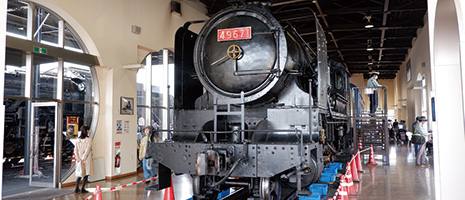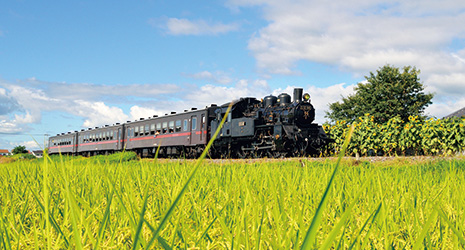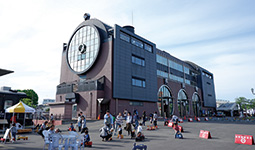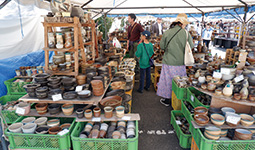Home > Highlighting JAPAN > Highlighting Japan May 2019 > A Trip by Local Train
Highlighting JAPAN


- PREVIOUS
- NEXT
Travel by Good Old-fashioned Steam Locomotive
The Moka Line, which runs near the border between Ibaraki and Tochigi Prefectures, is a perfect local railroad for viewing peaceful rural scenery from the windows of a train, stopping along the way to experience traditional craft making or to enjoy the countryside and culture. On weekends and holidays, the SL (steam locomotive) Moka makes the journey even more enjoyable.
The Moka Line is a 41.9-km-long railway linking Shimodate Station in Chikusai City, Ibaraki Prefecture, and Motegi Station in Motegi Town, Tochigi Prefecture. The railway has a long history, having operated along its entire length since 1920. The line is managed and operated by Moka Railway, a third sector corporation financed by public bodies such as Tochigi Prefecture and Moka City chambers of commerce, agricultural cooperatives and banks.
Moka Railway usually operates a one-car train that travels between Shimodate and Motegi Stations on the Moka Line in about one hour and 15 minutes. On weekends and holidays, however, the company also operates the SL Moka, a steam locomotive with three cars. SL Moka, which started operation in 1994, makes one leisurely round trip between Shimodate Station and Motegi Station, attracting many railway enthusiasts from across the country.
Because the Moka Line, which is a non-electrified line, has no overhead wires or connecting poles, there is nothing to obstruct the field of vision either of passengers inside the train or of trainspotters along the line. The attraction of SL Moka is the enjoyment of seeing how trains looked before railways became electrified. Railroad enthusiasts carrying long-lens cameras gather to take photos along the line.
Ataru Takemae, an employee of the General Affairs Division of Moka Railway, says, “SL Moka reminds us of the age when the steam locomotive was in operation in Japan. Traveling on the line you see cherry and rapeseed blossoms in spring, hydrangea blossoms in the summer and cosmos blossoms in the fall. The train runs through snow-covered scenery in winter. You can enjoy a relaxing trip in the peaceful atmosphere of a Moka Line train.”
Almost all of the seventeen stations on the Moka Line are small unmanned stations that blend in perfectly with the countryside scenery. But Moka Station, which is the central station of the railway, is unique. The station building, which was rebuilt in 1997, is a four-story structure shaped like a steam locomotive. Its front and sides are designed with large, round glass windows. Just next to Moka Station stands SL 96 Museum, which, just like the station, is shaped like a steam locomotive. SL 96 Museum, which opened in 2013, has an exhibition of trains, including steam locomotives and diesel-powered cars that were in operation in every corner of the country. The steam locomotives of the 9600 Model made in 1920 and the D51 Model made in 1938, which ran in Hokkaido, are preserved in functional condition. The 9600 Model makes compressed air-powered demonstration runs of dozens of meters three times a day on weekends and holidays.
There are many tourist spots along the Moka Line, like the Kubo Memorial Tourism and Culture Exchange Center, which displays valuable historic structures from the Meiji and Taisho periods (1868–1912 and 1912–1926); Moka Igashira Onsen, where you can enjoy an open-air bath; and Michi no eki Motegi, where you can enjoy shopping for fresh vegetables and regional delicacies using local agricultural products.
Mashiko Town, where quality porcelain clay is produced, has developed as the producer of Mashiko ware since the late Edo period (1603–1868), and is a particularly popular stop on the line. Simple and warm Mashiko ware is used mainly for daily-use items like water jars, pots and dishes. There are about 250 potteries and about 50 pottery shops in the town, including many where you can experience pottery-making using a potter’s wheel. In May and November, the Mashiko Pottery Fair is held, and the town comes alive with many visitors. In addition to the usual shops, more than 500 tents line the streets offering many types of pottery to the Fair’s over 600,000 visitors.
If you study local history at Kubo Memorial Tourism and Culture Exchange Center, relax in an open-air bath at Moka Igashira Onsen, enjoy shopping for souvenirs at Michi no eki Motegi, experience pottery-making in Mashiko and then take a beautiful steam locomotive running with strong billows of white smoke and whistles, you will have enjoyed a trip filled with many of the local attractions.
- PREVIOUS
- NEXT
© 2009 Cabinet Office, Government of Japan









